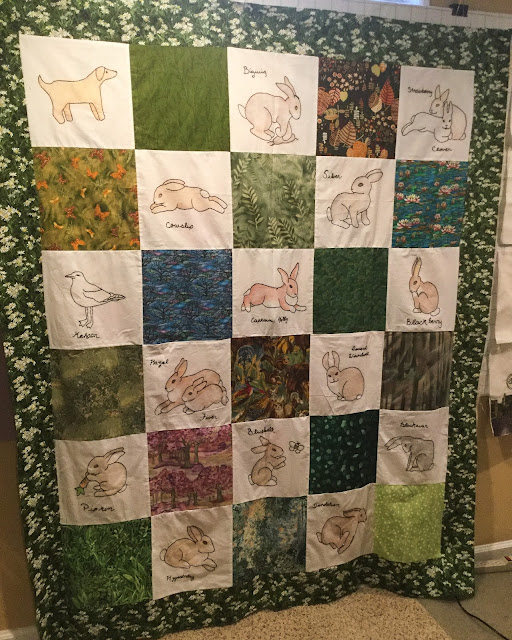"How do I develop my artistic voice, and what exactly is that?" is the second most asked question in Sandra Sider's art quilt critique workshops. Inspired by the closing statement in Michelle Obama's memoir Becoming, "there's power in allowing yourself to be known and heard, in owning your unique story, in using your authentic voice," Sider was motivated to take the risk of sharing her quilts and journey as an artist in the public platform of a book.
 |
| Stir Crazy by Sandra Sider, 60 x 42 in. Cyanotype photograms, paint on cotton |
Sider shares the quilts she made over her career, explaining her growth in technique and artistic eye. She was not interested in traditional "pretty" quilts, but art that evoked a response.
Sider shares what she has learned.
"Artistic voice" is not a goal, but a process, Sider writes. We sometimes get lost in the process or making a piece. We are warned to keep the purpose of your art piece in mind. Editing is important; too much machine quilting can obscure, fabric color choices may not match the message, over embellishing can create confusion.
Art education is ongoing for the artist, always trying new techniques and materials. Viewing art exhibitions can lead to new insights and inspiration. Draw from everything in your life. Keep a notebook of ideas, listen to critiques. Self-promotion is a part of a quilt artist's success.
Sider's book will inspire quilt artists in their journey. Her ability to self-critique makes her a sympathetic and approachable teacher.
I was given access to a free egalley by the publisher through NetGalley. My review is fair and unbiased.
Chapters:
Read Sider's bio here.
Read an interview with Sider at Create Whimsy here.
Images are from the author's website.
Exploring Your Artistic Voice in Contemporary Quilt Art
by Sandra Sider
Schiffer Publishing Ltd.
Pub Date 28 Jan 2020
112 pages 60 color images
ISBN: 9780764358876
$16.99 (USD) paperback
 |
| Stem Cells by Sandra Sider |
"Artistic voice" is not a goal, but a process, Sider writes. We sometimes get lost in the process or making a piece. We are warned to keep the purpose of your art piece in mind. Editing is important; too much machine quilting can obscure, fabric color choices may not match the message, over embellishing can create confusion.
Art education is ongoing for the artist, always trying new techniques and materials. Viewing art exhibitions can lead to new insights and inspiration. Draw from everything in your life. Keep a notebook of ideas, listen to critiques. Self-promotion is a part of a quilt artist's success.
 |
| Road Rage, digitally manipulated images of a Utah License plate, was inspired by a solo cross-country drive |
I was given access to a free egalley by the publisher through NetGalley. My review is fair and unbiased.
Chapters:
- How Many Things Do You Know?
- How Many Things Can You Do?
- Does Your Art Education Ever End?
- You Call Yourself an Artist
- Why Critiques Can Be Helpful
- Using Your Voice
Read Sider's bio here.
Read an interview with Sider at Create Whimsy here.
Images are from the author's website.
Exploring Your Artistic Voice in Contemporary Quilt Art
by Sandra Sider
Schiffer Publishing Ltd.
Pub Date 28 Jan 2020
112 pages 60 color images
ISBN: 9780764358876
$16.99 (USD) paperback
from the publisher:This compact guide will make a huge impact on how you choose to express yourself in quilt art. Think of the artists whose work you admire, individuals with a distinctive style or perhaps several styles developed over the years. You might like their use of color, materials, craft expertise, and subject matter. But above all, you recognize in these makers an authenticity, a confident approach to the quilt medium. That is their artistic voice. Develop your own unique artistic voice, see your work mature, and become confident and happy with what you are doing in the studio. Renowned quilt artist Sandra Sider acts as a companion along the path to discovering your voice, and offers photos of dozens of her own quilt design successes and failures as examples to learn from. Even blind alleys, detours, and the road not taken can lead to developing one’s voice as a quilt artist—indeed, as any sort of creative maker. Topics include how to write a powerful artist's statement for yourself, when to stop experimenting, and using your voice once you own it. Looking to broaden your quilting experience, or simply curious about the concept of an artistic voice? Look no further—this is the perfect guide for you!


























































